A new panel upgrade could be a few thousand dollars to the cost of a small home. But don’t forget about the ongoing costs, which include database subscriptions, firmware updates to the avionics hardware, the cost of computer hardware to support the database upgrades, database cards and your time (which for some is priceless).
Avionics database tech and pricing are a bit like spaghetti. It varies based upon the specifics of the avionics hardware, the geography of where you operate the aircraft, the hardware required to manage the database updates, the database vendors and how many databases you need to meet your flight requirements. When reviewing vendor pricing and options, it can result in a bit of an eye chart. Here’s a primer to start your planning in the right direction.
REQUIREMENTS
From an FAA and Transport Canada perspective, we have a regulatory requirement to fly with up-to-date charting and databases. Tablet apps may be easier than panel-mounted gear. ForeFlight, as one example, has an auto-download feature, which keeps your Electronic Flight Bag’s databases current (assuming that you turn on your iPad, attach to the internet and open ForeFlight). When you power up your avionics, most panel-mounted systems provide a message screen with the date of the database cycles, essentially reminding you of the age of the databases.
I’m curious about the insurance impacts of flying with outdated data in the event of an insurance claim (caused by flight into IMC). There’s a ton of data. Avionics databases might include obstacles, terrain, navigation data, maps, airport directories, frequencies, taxiways and IFR/VFR digital charts.
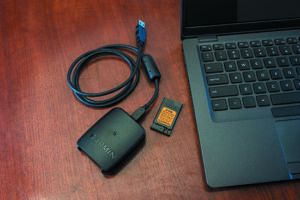
For those buyers considering a complete panel redo, the annual cost of database updates gets into serious money. For example, think about a panel with two navcoms, a primary flight display, a multifunction flight display and portable products like ForeFlight or Garmin’s aera 760. Interestingly, Garmin includes nav data updates free of charge for some of their aviation smartwatches (e.g., D2 Mach 1). For the purposes of this article “flight decks” (FD) will be used to encompass all aircraft systems that contain data and databases.
Modern panels require updating software (applications running on the hardware), firmware (software instructions providing low-level control of the hardware) and databases (an organized collection of data) over time. For example, chart, navigation and airport directory database updates occur every 14, 28 and 56 days, while terrain data is infrequently updated. Software updates, released by the avionics manufacturer, enhance hardware through resolving software bugs, enhancing performance and adding new features.
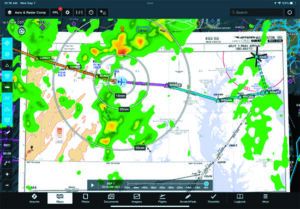
Firmware updates take software upgrades one step closer to the hardware layer of the avionics suite and are typically implemented by a qualified avionics shop. Based upon the databases you subscribe to, you can spend a lot of time each month updating databases. On the other hand, pilots who fly VFR may not update data at all—which isn’t exactly the right approach.
THE DATA WITHIN
Integrated flight decks record and store lots of data (engine and flight data generated by attitude and heading reference systems as one example), which has proven useful for crash investigations and maintenance troubleshooting. A variety of connections from physical cards, Wi-Fi, Bluetooth and satellite data networks can be used to offload data from the aircraft. Depending upon the avionics hardware in your panel, specific data cards will be used.
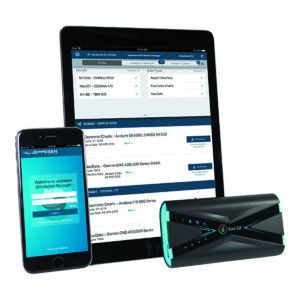
In older Garmin GNS navigators (e.g., Garmin GNS 530W), proprietary cards are used. However, the current avionics suites will typically use Secure Digital (SD) cards. However, they tend to have some elements of proprietary technology designed to defeat pilot/owners who may try to share their cards (and databases) with their friends. Subsequently, you typically cannot buy a $20 SD card on Amazon and use it to update your flight decks (some exceptions apply). Many aerospace manufacturers have created applications to facilitate laptop and tablet integration into their panels to support the uploading and downloading process. Garmin’s Database Concierge, part of their Connext ecosystem, utilizes an iPad or Android device running Garmin Pilot to push database updates to their GTN or GTN Xi series touchscreen navigators and FDs. Wi-Fi or Bluetooth integration into their avionics suites is accomplished with Garmin’s Flight Stream 510 Wi-Fi multimedia card.
WHERE TO YOU BUY ‘EM?
Aviation databases can be purchased from a handful of vendors including Garmin, Jeppesen and Seattle Avionics Software. When deciding which vendor to purchase data from, you need to consider not only the avionics that they support, but also the computer (and its operating system) used for the transfer, e.g., PC or Apple Mac. Each database vendor uses a completely different process to move and install the databases from their website to your avionics. Depending upon the age of your panel equipment, like a Garmin 530 WAAS versus a Garmin 750, the cost of the additional hardware (to facilitate the transfer) will vary.
For example, the Garmin GNS 530/430Ws in the Commander that I fly, when using Jeppesen data, require a Jeppesen Skybound USB adapter, Jeppesen Distribution Manager (software), a PC/Mac/iPad and Jeppesen propriety cards. Moreover, hidden costs can occur if the cards become corrupted during a transfer. Jeppesen typically advises customers to buy another card. The cost of the navigation database card for our GNS 530W is $215 each. There are four database cards in our stack. For a Garmin G1000, the cost of cards is $199.95 each. Aspen Evolution display SD cards are $200 each and can be purchased directly from Aspen dealers.
You also should consider the process and time it takes to implement the updates. To help avoid becoming AOG during the update process, consider having a second set of cards, rotating them between updates. Don’t wait until the morning of an important trip to do the update.
DOING THE DEED
Updating databases is typically a multi-step process, beginning with purchasing a subscription, followed by downloading the databases to your computer or iPad. Depending upon the location of your aircraft, you might not be able to do this in the hanger. You might consider either an iPad or laptop computer with a cellular LTE/5G connection to facilitate the download.
However, this will vary depending upon the provider of the databases and the software that they use. Michael Studley, director of customer service, field service engineering, northeast sales, Aspen Avionics reports, “Many of our customers will buy a second set of SD cards from Aspen and will rotate them so that they are able to update databases from the convenience of their homes. While we don’t see a lot of SD card corruption issues (during updating), it seems that data corruption is more prone to happen when Apple Mac computers are used.”
Aircraft database storage containers add more complexity to managing the databases. For example, Garmin’s GNS 530/430 data cards are proprietary, use a non-standard writer and have three different card types, denoted by green, silver and orange labels, based upon the specifics of the GNS 530/430 (WAAS and non-WAAS). Jeppesen’s Skybound writer adapter is tied to the type of cards. A Skybound G2 silver-tagged adapter is not able to update Garmin orange data cards. Garmin’s USB Aviation Data Card Programmer will program Garmin navigation, obstacle and terrain databases, but is not compatible with Jeppesen’s software and Jeppesen’s Skybound adapter, adding more complexity to the process.
Jeppesen data is sold based upon geography, type of aircraft and avionics hardware. From a geography perspective, Jeppesen has pricing plans based upon North America, Full USA, North America/Europe/North Atlantic, Worldwide and Americas. Data can be purchased as a one-time or an annual subscription. As a result, the annual or one-time costs will vary based upon the hardware in your aircraft (I would think that the cost matrix would look like an eye chart). Jeppesen offers Obstacles, Digital Charts and Navigation Data. Obstacles includes the locations of towers, tall buildings and other vertical obstructions that could be a potential hazard to pilots and updates every 56 days. Digital Chart Services are full-color, high-quality, vector-based electronic terminal charts (e.g., Jepp plates) in a variety of configurations for use in panel-mounted avionics, mobile devices and in ground-based applications. They include geo-referenced SID, STAR, approach and airport diagram charts and update every 14 days. NavData delivers coverage for over 7000 global airports, with a database that is three times the size of any other provider. Helicopter options may be available depending on avionics brand and model. NavData updates occur every 28 days.
HIDDEN COSTS, HARDWARE
Download manager software requires minimum computer operating system requirements, with the outcome of more computer hardware to keep up to date or replace. A hidden cost of avionics database upgrades is the computer used to maintain the software to facilitate the database card updates. Previous versions of Jeppesen’s Distribution Manager (JDM) only supported Windows PCs. For pilot/owners who are Windows users, this is typically not an issue. However, for Apple Mac users, this presented the issue of investing into a Windows laptop for this singular function. Over time, as Jeppesen created new versions of JDM, they moved the minimum Windows Operating System requirements. Depending upon your laptop hardware, upgrading to the latest version of Microsoft Windows could require a laptop hardware upgrade. Again, a hidden cost of keeping the laptop up to date, not only the operating system, but also anti-virus software. Fortunately, Jeppesen released a Mac OS version of JDM called JDM MacOS. JDM requires Mac OS 10.15 (Catalina) or newer.
Another hidden cost is the time to manage the operating systems installed on the PC/Mac. Jeppesen warns that its testing has identified that changes implemented by Apple in the October release of macOS 13 (Ventura) will cause the current version of JDM to malfunction. To ensure that you can continue to download and transfer JDM data updates, don’t update to macOS 13 (Ventura) until a new version of JDM is available. Jeppesen said it will alert customers when a new version of JDM is available to install and it is OK to update to macOS 13. Discontinued GPS navigators are also problematic because JDM MacOS does not support the Garmin GNS 480/CNX 80, FreeFlight Approach+, Trimble TNL and Universal Avionics units.
And, depending upon your avionics hardware, different hardware/cards are used to update avionics databases. Jeppesen’s JDM Mobile is an iPad application that works in conjunction with a Bad Elf Wombat device (more on that in a minute). This approach allows databases to be updated while in the aircraft. It’s exceptionally handy if your airport does not have good cellular or Wi-Fi connectivity. Jeppesen has completed compatibility testing of JDM Mobile with iOS/iPad OS 15.5. However, JDM Mobile is not compatible with a lot of aging navigators, including the GNS 480/CNX 80 and also the MX20 MFD. Jeppesen has a list of supported avionics at www.jeppesen.com.
Bad Elf’s Wombat hardware (www.bad-elf.com) is designed to make the updating process simpler on specific aircraft hardware. The Wombat is about the size of a large power vault. With USB, SD card ports and an app, you can update aircraft panel avionics without having to bring the database cards back to your house/office and relying on a laptop or the airport’s Wi-Fi connections. Using JDM Mobile, update files can be downloaded onto an iPad anywhere that has a high-speed internet connection. At the aircraft, simply pop the card out of the navigator and insert it into the slot on the Wombat. For Garmin 530/430s, the Jeppesen Skybound adapter is still required and is attached to the Wombat’s USB port. You then use JDM Mobile to continue the transfer of the databases onto the card. Once the transfer is completed, simply remove the card from the Wombat and insert it back into your avionics hardware. The Wombat and JDM Mobile will not update Garmin obstacle and terrain databases.
The Wombat is a multi-tool product, which is able to upload data from SD or USB sticks directly into cloud-based management tools like Savvy Analysis, CloudAhoy, MyTBM and Cirrus Reports. With a built-in battery, you don’t have to worry about power connections in the aircraft. I think it’s a fast and we’ll thought out technology that simplifies the updating of your databases. Wombat for piston aircraft retails for $249.99 (one-year warranty) and $499.99 (three-year warranty) for the turbine version. The Wombat Turbine Edition requires an annual $100 service fee after the first year. As noted, this approach will not work for terrain data.
OPTIONS FOR GARMIN
Depending upon the Garmin avionics hardware installed in your aircraft, different cards may be used. Some older navigators, like the GTN 530W installed in my Commander, use proprietary cards that must remain in the 530W. Navigation data is installed on one card and terrain data is stored on another card. The terrain card is maintained in the left-most slot. Newer Garmin flight deck hardware, like the G500/600 series, has two SD slots, one on top and one on the bottom of the flight display. The Garmin Supplemental Data card is stored in the bottom slot of the G500 and contains the following databases: Basemap, Obstacle, Terrain, Garmin FliteCharts or Jeppesen ChartView, SafeTaxi and Airport Directory (AOPA). For the G500/600, Jeppesen NavData databases are loaded onto a SD card (no larger than 4GB) and should not be loaded onto the Garmin Supplemental Data card. The Jeppesen data SD card is placed into the top slot of the G500/600.
Updating is pretty simple: Power on the system and follow the prompts. The Jeppesen data will be copied into the display LRU, after which the SD card can be removed from the slot.
Optional for Garmin GTN navigators (and standard on Garmin’s GNX 375/GPS 175/GNC 355 units) is the Flight Stream 510 wireless module, which is built into an SD card (older Flight Stream 110 and 210 hardware do not support Database Concierge updates) and can be used to wirelessly update the panel’s databases using the Garmin Pilot app. A word of caution for any nav/software update: Make sure there is sufficient external power (aircraft, iPad/laptop) to complete the update process. If you’re not sure about the capacity of the ship’s battery, consider using a portable ground power unit (GPU). The White Lightning GPU from Audio Authority is one that comes to mind, and we’ll scan the market for more in a separate article.
Garmin databases are purchased at www.flyGarmin.com. They can be purchased as either a OnePaks database subscription, PilotPaks subscription or individual databases. OnePaks and PilotPaks bundle a variety of databases into a single annual price.
OnePaks provides navigation databases using Garmin data while PilotPaks adds Jeppesen navigation data. Pricing provides databases for two navigators, two flight displays, one portable device or Garmin Pilot Premium (however, a Garmin Pilot Standard subscription is required, $260 per year for U.S. and Canada subscriptions). Compared to purchasing individual annual subscriptions to each database type for each device, OnePaks and PilotPaks can offer significant savings, but aren’t available for all units. There are too many pricing/hardware combinations to list here.
Start at www.flyGarmin.com. The pricing process begins with selecting a Garmin device (e.g., Garmin G1000), aircraft make and aircraft model. Garmin offers Standard or Standard Plus FliteCharts for different geographies like Americas, Canada and United States. OnePaks and PilotPaks database subscriptions provide the databases (within the selected package) for all the compatible Garmin avionics installed in a single aircraft, all for one annual price. Each PilotPak (except Lite) features Jeppesen NavData for the specified coverage area. Individual databases for a variety of data can be purchased either as a one-time or annual subscription. Individual databases include Airport Directory, Basemap, FliteCharts, Navigation Data, Obstacle, SafeTaxi and Terrain. PilotPaks includes Jeppesen NavData in all but their Lite offering. In the case of Lite, Garmin offers Garmin FliteCharts. As an example, using a C182 and G1000, OnePaks annual pricing ranges for $669 to $999 depending upon the package and geography, while PilotPaks annual pricing ranges from $789 to $1869 depending upon the package and geography. Individual database pricing ranges from $54.95 to a high of $981.
For those with a legacy Garmin stack (e.g., GNS 530/430), you may choose to purchase Jeppesen updates versus Garmin databases. However, Jeppesen does not offer terrain data. In this case, you would purchase terrain data from Garmin ($150 for a worldwide terrain update). Garmin infrequently updates the terrain data. The last terrain database update was in August 2020 with the next update expected in two or three years. Consider reviewing the status of your terrain database at your next annual inspection. Also, in the case of a GNS 530/430, the terrain databases can only be upgraded using the Garmin USB Aviation Data Card GNS Series Programmer ($82.75 at Aircraft Spruce). Pro tip: Depending upon your specific computer, you may need to download Garmin’s software drivers for the programmer.
LOADING THE DATA
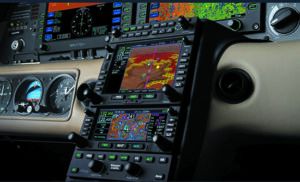
Garmin Aviation Database Manager (GADM) is Garmin’s software tool to update databases. Garmin supports both PC and Mac. GADM is used to update Garmin panel avionics, portables and smartwatch databases. It’s a pretty simple process. Begin by downloading and installing GADM. When GADM launches, it checks to see if it is the most recent version and prompts you to install the app upgrade. As with any software installation or upgrade, the software may experience a problem being installed and quit unexpectedly. Pro tip: If you have problems with an app crashing, try relaunching it. If that doesn’t work, try rebooting your Mac or PC. If that doesn’t work, you’re on the phone with Garmin Aviation Technical Support, where wait times may be long, but Garmin offers a callback service.
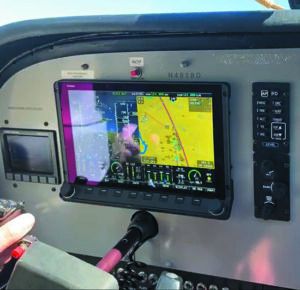
GADM will show you two tabs, Aircraft and Portable. Select the tab, and the devices will be displayed. You can select either Update/Reinstall or Calendar View for a specific device. Calendar view is a nifty tool that shows each database cycle (e.g., October 2022, cycle 2210) and based upon the current date, whether your device’s data is current or expired. To update, simply press the update button on the top of the screen, followed by the continue button. The process is pretty simple. In the case of a D2 Air smartwatch, the app will download the database, transfer to the smartwatch and then display an Updates Complete for D2 Air screen. However, the message on the screen says “You can now safely eject the SD card. To complete the database update, you must now install the SD card in your avionics.” This is clearly a message used for their panel-mounted avionics process.
I’m curious when Garmin will go through GADM to update their messages. Interestingly, if you have to return a Garmin smartwatch for warranty reasons and replace it with a new one, you cannot delete the returned device from GADM or flyGarmin.com. In this case both smartwatches will be displayed. To delete the returned device, you will need to call Garmin to delete the device from GADM and flyGarmin.com.
SEATTLE AVIONICS
The third vendor in the aviation database market is Seattle Avionics, the developer of the FlyQ app, but they also sell databases. Their app, ChartData Manager, is used to download ChartData for Dynon, Aspen, BendixKing, GRT, AFS and other avionics systems. ChartData Manager requires a Microsoft Windows laptop or desktop computer running Windows 7 or newer. Sadly, it is not supported on MacOS. USB drives and SD memory cards can be formatted and prepared for some apps and devices using the Storage Manager. The Data Manager can automatically run in the background when Windows starts so data is automatically downloaded. This removes the need for the user to manually start the Data Manager and press the Update Now button. Automatic downloads can be disabled in the Options screen.
The subscription price for ChartData is based upon the avionics hardware in your aircraft. For example, Seattle Avionics offers each Aspen customer 90 days of free U.S. ChartData updates (enough for three cycles of 28-day updates). After that, annual U.S. subscriptions are available for $299. Annual European subscriptions are $679. Each subscription includes FAA-certified geo-referenced IFR and VFR approach plates, airport diagrams, Mins, Arrival Procedures and Departure Procedures. Once a subscription is purchased, ChartData is downloaded automatically to your PC via their Data Manager and then transferred, in the case of Aspen, to an Aspen 16 GB SD card for use inflight.
Aspen has an interesting software platform called the Connected Panel, which was released in 2011. It’s a wirelessly connected network incorporating Aspen Flight Displays and a variety of certified avionics from Garmin and Honeywell. Connected Pilot is designed for Apple iOS mobile devices and is able to receive data from many panel-mounted GPS navigators. Connected Pilot can enter and synchronize flight plans between Garmin GNS 400W/500W series navigators (the GNS 480 is not a compatible device), Honeywell Primus Apex avionics suite and Aspen’s Connected Panel-enabled flight planning apps.
The heart of the Connected Panel ecosystem is Aspen’s CG100 Connected Gateway hardware, which provides secure, authenticated and encrypted two-way wireless communications between the aircraft’s certified panel avionics and personal smart devices. Connected Pilot costs $2499 and can be integrated with Aspen Evolution Multi-Function Flight Displays including 1500, 2000 or 2500.
This technology was adopted by Pilatus on their PC-12 and PC-24 aircraft. Based upon a change to Garmin’s GNS 530/430 firmware and upon an ADS-B integration, connectivity of Aspen’s Connected Panel to Garmin GNS navigators stopped working, obsoleting the Aspen Connected Panel technology. While it is an innovative technology, development, marketing and sales have ceased with the exception of the Pilatus airframes.
GROWING COMPLEXITY
As aircraft migrate from round gauges to digital flight displays, the selection of aviation databases becomes more complex, especially if you are in a flagship avionics environment. With databases tied to the hardware in your aircraft’s panel and your tablet, the database costs and the updating process can become more complex.
To ensure that your avionics are up to date and that you are legal to fly (think IFR), you might consider adding data updates as maintenance event, similar to oil changes. Calendar entries help remind you to download and transfer the new database cycles onto your avionics. For pilots who fly infrequently, it’s easy to forget this important chore, especially as some of us become older and our memories become foggy. After all, the last thing that we want to do is shoot an approach to minimums with old and outdated data.





